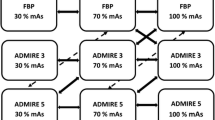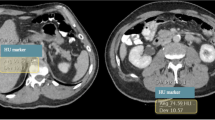Abstract
Purpose
Pure iterative reconstruction (Pure IR) has been proposed as a solution to improve diagnostic quality of low dose CT images. We assess the performance of model based iterative reconstruction (MBIR) in improving conventional dose CT enterography (CTE) images.
Methods
43 Crohn’s patients (27 female) (38.5 ± 12.98 years) referred for CTE were included. Images were reconstructed with pure IR (MBIR, General Electric Healthcare) in addition to standard department protocol (reconstructed with hybrid iterative reconstruction (Hybrid IR) [60% filtered back projection/40% adaptive statistical IR (General Electric Healthcare)]. Image quality was assessed objectively and subjectively at 6 anatomical levels. Clinical interpretation was undertaken in consensus by 2 blinded radiologists along with 2 non-blinded readers (‘gold standard’). Results were analyzed using Statistical Package for Social Scientists.
Results
Mean effective radiation dose was 6.05 ± 2.84 mSv (size specific dose estimates 9.25 ± 2.9 mGy). Objective and subjective assessment yielded 6106 data points. Pure IR images significantly outperformed those using standard reconstruction techniques across all subjective (p < 0.001 for all comparisons) (noise, contrast resolution, spatial resolution, streak artifact, axial diagnostic acceptability, coronal diagnostic acceptability) and objective (p < 0.004) (noise, signal-to-noise ratio) parameters. Clinical reads of the pure IR images agreed more closely with the gold standard reads than the hybrid IR image reads in terms of overall Crohn’s activity grade (κ = 0.630, 0.308) and detection of acute complications (κ = 1.0, 0.896). Results were comparable for bowel wall disease severity assessment (κ = 0.523, 0.593).
Conclusions
Pure IR considerably improves image quality of conventional dose CTE images and therefore its use should be expanded beyond low dose protocols to improving image quality at conventional dose CT imaging.





Similar content being viewed by others
References
Winklehner A, Karlo C, Puippe G, et al. (2011) Raw data-based iterative reconstruction in body CTA: evaluation of radiation dose saving potential. Eur Radiol 21(12):2521–2526
Singh S, Kalra MK, Do S, et al. (2012) Comparison of hybrid and pure iterative reconstruction techniques with conventional filtered back projection: dose reduction potential in the abdomen. J Comput Assist Tomogr 36(3):347–353
Prakash P, Kalra MK, Kambadakone AK, et al. (2010) Reducing abdominal CT radiation dose with adaptive statistical iterative reconstruction technique. Invest Radiol 45(4):202–210
Nelson RC, Feuerlein S, Boll DT (2011) New iterative reconstruction techniques for cardiovascular computed tomography: how do they work, and what are the advantages and disadvantages? J Cardiovasc Comput Tomogr 5(5):286–292
Pickhardt PJ, Lubner MG, Kim DH, et al. (2012) Abdominal CT with model-based iterative reconstruction (MBIR): initial results of a prospective trial comparing ultralow-dose with standard-dose imaging. AJR Am J Roentgenol 199(6):1266–1274
Yasaka K, Katsura M, Akahane M, et al. (2013) Model-based iterative reconstruction for reduction of radiation dose in abdominopelvic CT: comparison to adaptive statistical iterative reconstruction. Springerplus 2(1):209
Craig O, O’Neill S, O’Neill F, et al. (2012) Diagnostic accuracy of computed tomography using lower doses of radiation for patients with Crohn’s disease. Clin Gastroenterol Hepatol 10(8):886–892
Desai GS, Uppot RN, Yu EW, Kambadakone AR, Sahani DV (2012) Impact of iterative reconstruction on image quality and radiation dose in multidetector CT of large body size adults. Eur Radiol 22(8):1631–1640
O’Neill SB, Mc Laughlin PD, Crush L, et al. (2013) A prospective feasibility study of sub-millisievert abdominopelvic CT using iterative reconstruction in Crohn’s disease. Eur Radiol 23(9):2503–2512
Vardhanabhuti V, Loader R, Roobottom CA (2013) Assessment of image quality on effects of varying tube voltage and automatic tube current modulation with hybrid and pure iterative reconstruction techniques in abdominal/pelvic CT: a phantom study. Invest Radiol 48(3):167–174
Suzuki S, Machida H, Tanaka I, Ueno E (2012) Measurement of vascular wall attenuation: comparison of CT angiography using model-based iterative reconstruction with standard filtered back-projection algorithm CT in vitro. Eur J Radiol 81(11):3348–3353
Suzuki S, Machida H, Tanaka I, Ueno E (2013) Vascular diameter measurement in CT angiography: comparison of model-based iterative reconstruction and standard filtered back projection algorithms in vitro. AJR Am J Roentgenol 200(3):652–657
Yoon MA, Kim SH, Lee JM, et al. (2012) Adaptive statistical iterative reconstruction and Veo: assessment of image quality and diagnostic performance in CT colonography at various radiation doses. J Comput Assist Tomogr 36(5):596–601
Suzuki S, Machida H, Tanaka I, Fukui R, Ueno E (2014) Diameter measurement of vascular model on CT angiography using model-based iterative reconstruction: effect of tube current on accuracy. AJR Am J Roentgenol 202(2):437–442
Katsura M, Sato J, Akahane M, et al. (2013) Comparison of pure and hybrid iterative reconstruction techniques with conventional filtered back projection: image quality assessment in the cervicothoracic region. Eur J Radiol 82(2):356–360
Machida H, Takeuchi H, Tanaka I, et al. (2013) Improved delineation of arteries in the posterior fossa of the brain by model-based iterative reconstruction in volume-rendered 3D CT angiography. AJNR Am J Neuroradiol 34(5):971–975
Shuman WP, Green DE, Busey JM, et al. (2013) Model-based iterative reconstruction versus adaptive statistical iterative reconstruction and filtered back projection in liver 64-MDCT: focal lesion detection, lesion conspicuity, and image noise. AJR Am J Roentgenol 200(5):1071–1076
Vardhanabhuti V, Ilyas S, Gutteridge C, Freeman SJ, Roobottom CA (2013) Comparison of image quality between filtered back-projection and the adaptive statistical and novel model-based iterative reconstruction techniques in abdominal CT for renal calculi. Insights Imaging 4(5):661–669
Deák Z, Grimm JM, Treitl M, et al. (2013) Filtered back projection, adaptive statistical iterative reconstruction, and a model-based iterative reconstruction in abdominal CT: an experimental clinical study. Radiology 266(1):197–206
Lee SJ, Park SH, Kim AY, et al. (2011) A prospective comparison of standard-dose CT enterography and 50% reduced-dose CT enterography with and without noise reduction for evaluating Crohn disease. AJR Am J Roentgenol 197(1):50–57
Kambadakone AR, Chaudhary NA, Desai GS, et al. (2011) Low-dose MDCT and CT enterography of patients with Crohn disease: feasibility of adaptive statistical iterative reconstruction. AJR Am J Roentgenol 196(6):W743–W752
Kaza RK, Platt JF, Al-Hawary MM, et al. (2012) CT enterography at 80 kVp with adaptive statistical iterative reconstruction versus at 120 kVp with standard reconstruction: image quality, diagnostic adequacy, and dose reduction. AJR Am J Roentgenol 198(5):1084–1092
Brady SL, Kaufman RA (2012) Investigation of American Association of Physicists in Medicine Report 204 size-specific dose estimates for pediatric CT implementation. Radiology 265(3):832–840
Marin D, Nelson RC, Schindera ST, et al. (2010) Low-tube-voltage, high-tube-current multidetector abdominal CT: improved image quality and decreased radiation dose with adaptive statistical iterative reconstruction algorithm–initial clinical experience. Radiology 254(1):145–153
Bongartz G, Geleijns J, Golding S, et al. (1999) European guidelines on quality criteria for computed tomography. European Commission.
Siddiki HA, Fidler JL, Fletcher JG, et al. (2009) Prospective comparison of state-of-the-art MR enterography and CT enterography in small-bowel Crohn’s disease. AJR Am J Roentgenol 193(1):113–121
Singh S, Kalra MK, Hsieh J, et al. (2010) Abdominal CT: comparison of adaptive statistical iterative and filtered back projection reconstruction techniques. Radiology 257(2):373–383
Desmond AN, O’Regan K, Malik N, et al. (2012) Selection of symptomatic patients with Crohn’s disease for abdominopelvic computed tomography: role of serum C-reactive protein. Can Assoc Radiol J 63:267–274.
Jackson VP, Cushing T, Abujudeh HH, et al. (2009) RADPEER scoring white paper. J Am Coll Radiol 6(1):21–25.
Author information
Authors and Affiliations
Corresponding author
Rights and permissions
About this article
Cite this article
Murphy, K.P., Crush, L., McLaughlin, P.D. et al. The role of pure iterative reconstruction in conventional dose CT enterography. Abdom Imaging 40, 251–257 (2015). https://doi.org/10.1007/s00261-014-0222-x
Published:
Issue Date:
DOI: https://doi.org/10.1007/s00261-014-0222-x




